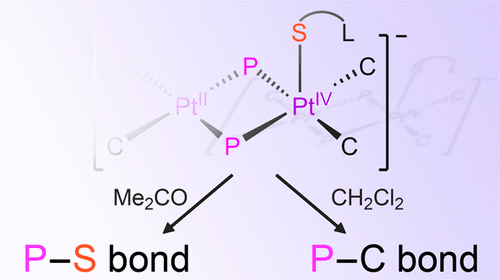当前位置:
X-MOL 学术
›
Organometallics
›
论文详情
Our official English website, www.x-mol.net, welcomes your
feedback! (Note: you will need to create a separate account there.)
Solvent-Driven P–S vs P–C Bond Formation from a Diplatinum(III) Complex and Sulfur-Based Anions
Organometallics ( IF 2.5 ) Pub Date : 2017-11-01 00:00:00 , DOI: 10.1021/acs.organomet.7b00746 Consuelo Fortuño 1 , Antonio Martín 1 , Piero Mastrorilli 2 , Vito Gallo 2 , Stefano Todisco 2
Organometallics ( IF 2.5 ) Pub Date : 2017-11-01 00:00:00 , DOI: 10.1021/acs.organomet.7b00746 Consuelo Fortuño 1 , Antonio Martín 1 , Piero Mastrorilli 2 , Vito Gallo 2 , Stefano Todisco 2
Affiliation

|
The outcome of the reaction of the Pt(III),Pt(III) complex [(C6F5)2PtIII(μ-PPh2)2PtIII(C6F5)2](Pt–Pt) (1) with the S-based anions thiophenoxide (PhS–), ethyl xanthogenate (EtOCS2–), 2-mercaptopyrimidinate (pymS–), and 2-mercaptopyridinate (pyS–) was found to be dependent on the reaction solvent. The reactions carried out in acetone led to the formation of [NnBu4][(RF)2PtII(μ-PhS-PPh2)(μ-PPh2)PtII(RF)2] (2), [NnBu4][(RF)2PtII(μ-EtOCS2-PPh2)(μ-PPh2)PtII(RF)2] (3), [NnBu4][(RF)2PtII(μ-pymS-PPh2)(μ-PPh2)PtII(RF)2] (4), and [NnBu4][(RF)2PtII(μ-pyS–PPh2)(μ-PPh2)PtII(RF)2] (5), respectively (RF = C6F5). Complexes 2–5 display new Ph2P(SL) ligands exhibiting a κ2-P,S bridging coordination mode, which is derived from a reductive elimination of a PPh2 group and the S-based anion. Carrying out the reaction in dichloromethane afforded, in the cases of EtOCS2– and pymS–, the monobridged complexes [NnBu4][(PPh2RF)(RF)2PtII(μ-PPh2)PtII(EtOCS2)(RF)] (6) and [NnBu4][(PPh2RF)(RF)2PtII(μ-PPh2)PtII(pymS)(RF)] (7), respectively, which are derived from reductive elimination of a PPh2 group with a pentafluorophenyl ring. The reaction of 1 with EtOCS2K in acetonitrile yielded a mixture of 3 and 6 as a consequence of the concurrence of two processes: (a) the formation of 3 by a reaction that parallels the formation of 3 by 1 plus EtOCS2K in acetone and (b) the transformation of 1 into the neutral complex [(PPh2RF)(CH3CN)(RF)PtII(μ-PPh2)PtII(RF)2(CH3CN)] (8), which, in turn, reacts with EtOCS2K to give 6. The 1 to 8 transformation was found to be fully reversible. In fact, dissolving 8 in acetone or dichloromethane afforded pure 1 after solvent evaporation or crystallization with n-hexane. The XRD structures of 2–4 and 6–8 were determined, and the behavior in solution of the new complexes is discussed.
中文翻译:

由双铂(III)配合物和硫基阴离子形成的溶剂驱动的P–S与P–C键
铂(III),铂(III)络合物的反应的结果[(C 6 ˚F 5)2的Pt III(μ-PPH 2)2的Pt III(C 6 ˚F 5)2 ](铂-铂)(1)与S基阴离子噻吩(PhS –),黄原酸乙酯(EtOCS 2 –),2-巯基嘧啶酸酯(pymS –)和2-巯基吡啶酸酯(pyS –)依赖于反应溶剂。在丙酮中进行的反应导致[N n Bu 4的形成] [(R ˚F)2的Pt II(μ-PHS-PPH 2)(μ-PPH 2)的Pt II(R ˚F)2 ](2),[N Ñ卜4 ] [(R ˚F)2的Pt II( μ-EtOCS 2 -PPh 2)(μ-PPH 2)的Pt II(R ˚F)2 ](3),[N ñ卜4 ] [(R ˚F)2的Pt II(μ-pymS-PPH 2)(μ -PPh2)的Pt II(R ˚F)2 ](4),并且[N Ñ卜4 ] [(R ˚F)2的Pt II(μ-PYS-PPH 2)(μ-PPH 2)的Pt II(R ˚F)2 ](5)分别(R F = C 6 F 5)。配合物2 - 5显示新博士2 P(SL)配体显示出κ 2 - P,小号桥联配位模式,这是通过PPh 2基团和基于S的阴离子的还原消除而得出的。执行在二氯甲烷中反应,得到,在EtOCS的箱子2 -和pymS -时,monobridged络合物[N Ñ卜4 ] [(PPH 2 - [R ˚F)(R ˚F)2的Pt II(μ-PPH 2)的Pt II(EtOCS 2)(R F)](6)和[N n Bu 4 ] [(PPh 2 R F)(R F)2的Pt II(μ-PPH 2)的Pt II(pymS)(R ˚F)](7),分别,这是从一个PPH的还原消除衍生2基团与五氟苯基环。的反应1与EtOCS 2 K的乙腈,得到的混合物3和6作为两个过程的同意的结果:(A)形成的3由平行的形成的反应3由1加EtOCS 2 K的丙酮和(b)1转化为中性络合物[(PPh2 - [R ˚F)(CH 3 CN)(R ˚F)的Pt II(μ-PPH 2)的Pt II(R ˚F)2(CH 3 CN)](8),其又与EtOCS发生反应2 K至得到6。在1至8转变被认为是完全可逆的。事实上,溶解8在丙酮或二氯甲烷中,得到纯的1溶剂蒸发或结晶后用Ñ正己烷。XRD结构2 – 4和6–确定了8个,并讨论了新配合物在溶液中的行为。
更新日期:2017-11-02
中文翻译:

由双铂(III)配合物和硫基阴离子形成的溶剂驱动的P–S与P–C键
铂(III),铂(III)络合物的反应的结果[(C 6 ˚F 5)2的Pt III(μ-PPH 2)2的Pt III(C 6 ˚F 5)2 ](铂-铂)(1)与S基阴离子噻吩(PhS –),黄原酸乙酯(EtOCS 2 –),2-巯基嘧啶酸酯(pymS –)和2-巯基吡啶酸酯(pyS –)依赖于反应溶剂。在丙酮中进行的反应导致[N n Bu 4的形成] [(R ˚F)2的Pt II(μ-PHS-PPH 2)(μ-PPH 2)的Pt II(R ˚F)2 ](2),[N Ñ卜4 ] [(R ˚F)2的Pt II( μ-EtOCS 2 -PPh 2)(μ-PPH 2)的Pt II(R ˚F)2 ](3),[N ñ卜4 ] [(R ˚F)2的Pt II(μ-pymS-PPH 2)(μ -PPh2)的Pt II(R ˚F)2 ](4),并且[N Ñ卜4 ] [(R ˚F)2的Pt II(μ-PYS-PPH 2)(μ-PPH 2)的Pt II(R ˚F)2 ](5)分别(R F = C 6 F 5)。配合物2 - 5显示新博士2 P(SL)配体显示出κ 2 - P,小号桥联配位模式,这是通过PPh 2基团和基于S的阴离子的还原消除而得出的。执行在二氯甲烷中反应,得到,在EtOCS的箱子2 -和pymS -时,monobridged络合物[N Ñ卜4 ] [(PPH 2 - [R ˚F)(R ˚F)2的Pt II(μ-PPH 2)的Pt II(EtOCS 2)(R F)](6)和[N n Bu 4 ] [(PPh 2 R F)(R F)2的Pt II(μ-PPH 2)的Pt II(pymS)(R ˚F)](7),分别,这是从一个PPH的还原消除衍生2基团与五氟苯基环。的反应1与EtOCS 2 K的乙腈,得到的混合物3和6作为两个过程的同意的结果:(A)形成的3由平行的形成的反应3由1加EtOCS 2 K的丙酮和(b)1转化为中性络合物[(PPh2 - [R ˚F)(CH 3 CN)(R ˚F)的Pt II(μ-PPH 2)的Pt II(R ˚F)2(CH 3 CN)](8),其又与EtOCS发生反应2 K至得到6。在1至8转变被认为是完全可逆的。事实上,溶解8在丙酮或二氯甲烷中,得到纯的1溶剂蒸发或结晶后用Ñ正己烷。XRD结构2 – 4和6–确定了8个,并讨论了新配合物在溶液中的行为。











































 京公网安备 11010802027423号
京公网安备 11010802027423号